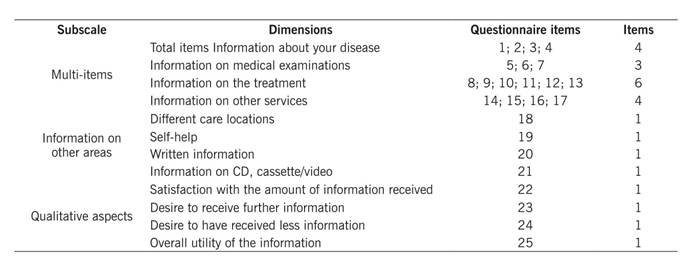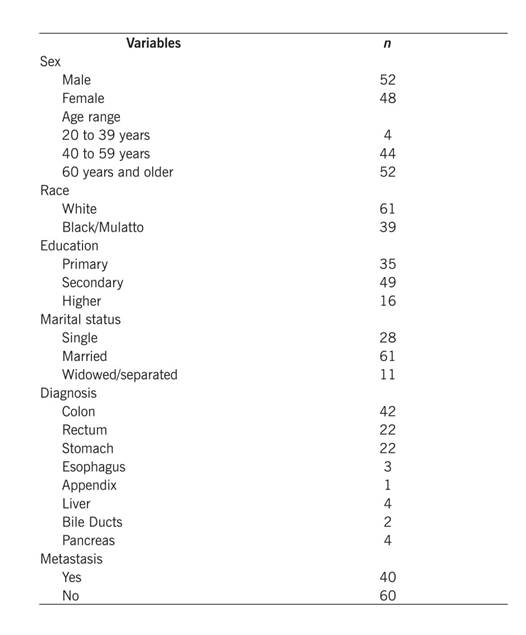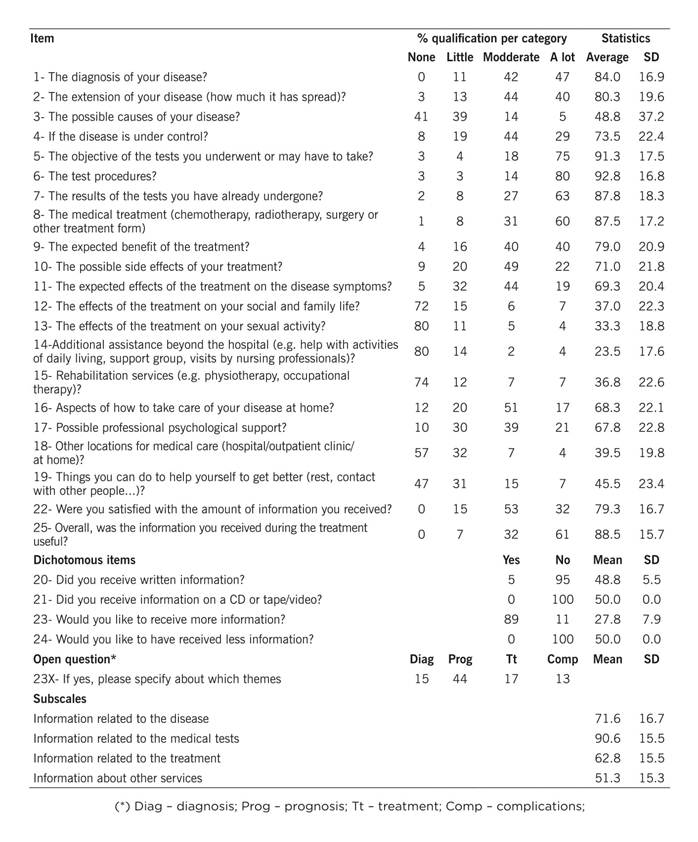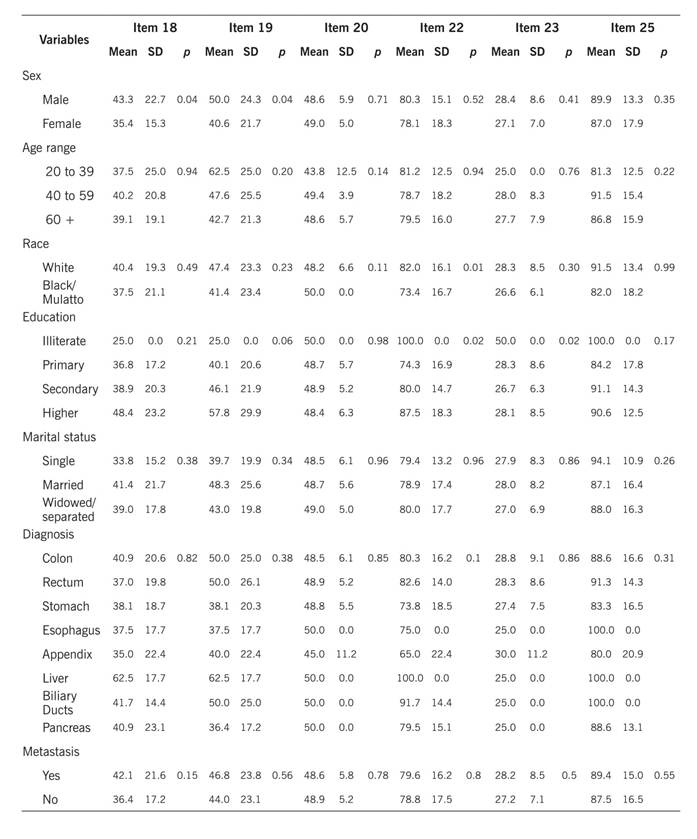Introduction
The incidence of cancer has considerably increased in Brazil. For Brazil, about 596 thousand new cancer cases are estimated for 2016-2017.1 When the disease progresses, important physical and psychosocial changes happen, which gain intensity with the evolution process of the disease.2 Therefore, it is known that approaching a cancer patient is a very difficult task, as it involves the transfer of countless pieces of information inherent in the disease, its diagnosis, prognosis, risks and benefits of the treatment, mutilations and other body image changes, besides the possibility of the irreversible progression of the disease.3) The information provided to the cancer patient about his disease and treatment can profoundly influence his wellbeing, changing the meaning of the symptoms, problems and the way the patient faces the disease and its treatment.4-6 One can say in this sense that the assessment of the information given to the cancer patient is an indicator of the quality of oncology care provided by the health institution.7,8 One form of clinical, diagnostic and social approach is to use adapted scales and questionnaires.9 To assess the amount of information the patients with different types of cancer receive during the phases of the diagnosis and treatment process, as well as for clinical and research purposes, the Quality of Life Group of the European Organization for Research and Treatment of Cancer (EORTC) developed the QLQ INFO 25 questionnaire,10,11 which was validated for the Brazilian context by Monique Silva Carvalho concerning the semantic equivalence; and by Claudia Fernandes Rodrigues concerning the test-retest reliability (unpublished).
The abdominal-pelvic tumors include some of the most incident in the general population. They comprise a diversified group of tumors, classified according to the anatomic location, the most incident types between colon and stomach cancer1. This topography entails some particularities. To give an example, surgical excision permits increasing patients’ survival and reduces the possibility that the disease will spread to other organs. Nevertheless, the large majority results in the establishment of stomas.11 The patients demonstrate difficulty to understand the surgery executed and its consequences. Therefore, there is a clear need for information about the disease, the therapeutic conducts, the physical and emotional changes deriving from the treatment, with a view to improving these patients’ quality of life. In this context, the objective in this study is to assess the need for information in patients with abdominal and pelvic tumors, using the QLQ- INFO25 questionnaire by EORTC.
Methods
In this cross-sectional study, a set of data was used about the need to provide information to abdominal cancer patients attended at the Instituto Nacional do Câncer (INCA). The research sample consisted of the universe of 100 adult patients hospitalized at the nursing ward for surgical patients with abdominal tumors of the Instituto Nacional do Câncer José de Alencar Gomes da Silva/INCA, located in the city of Rio de Janeiro. The participants were included between June and December 2016. The inclusion criteria were male or female patients aged 18 years or older with abdominal tumors. The exclusion criteria were patients with cognitive disorders capable of compromising the veracity of the answers, with central nervous system tumors or metastases. To collect the data, the interview strategy was adopted, after background information about the research objectives, agreement to participate in the study and signing of the free and informed consent form, in accordance with the recommendation of the questionnaire validation study.
Sociodemographic characteristics were assessed (age range, sex, marital status, education level, race, primary diagnosis and presence of metastasis). To assess the need for information, the EORTC-QLQ INFO25 questionnaire about the information the oncology patient received was used, validated for Brazil. This version of the questionnaire, QLQ-INFO25 by EORTC, used in this study, consists of 25 questions and four dimensions. The first refers to information on the disease (4 questions), the second aims to discover information about the medical examinations (3 questions), the third refers to information on the treatment (6 questions) and the fourth investigates information about other services (4 questions). Besides the four multi-item dimensions highlighted, the EORTC QLQ-INFO25 contains eight individual items, which address questions on different care locations, self-help attempts, receipt of written and digital information, satisfaction with the information received, desire to receive further information, desire to receive less information and the utility of the information received. Among the 25 questions, 21 are organized on a Likert scale (1 - None\No; 2 - Little\A little; 3 - Reasonable\Moderately; 4 -A lot\Much), while four have dichotomous answers (20, 21, 23, 24). In addition, items 23 and 24 include a second, open-ended question. Nevertheless, based on the answers obtained, the answers were categorized for analysis purposes. The following categories were created: diagnosis; prognosis; treatment and complications. The subscales and their respective items have been described in Table 1. It should be highlighted that the scale does not have a fixed cut-off point. In this care, the assessment by the expert committee that validated the scale was to recommend the use of the research population’s median score as a parameter whenever the scale is applied.
The scores were calculated for each subscale and the association between the subscales and the sociodemographic (sex, age, education, race, marital status) and clinical (tumor location, presence of metastases) variables was assessed. The means and standard deviations were analyzed for the multi-item dimensions in the EORTC QLQ-INFO25 questionnaire, divided and named subscale 1 (information on the diagnosis of the disease), subscale 2 (information on the medical examinations), subscale 3 (information on the treatment) and subscale 4 (information on other services) and the clinical and sociodemographic characteristics.
For the categorical variables, the ANOVA test was used and statistical significance was set at 95%. For the data analyses, the statistical software SPSS, version 22 was applied. This study received authorization from the INCA Ethics and Research Committee (CEP) and did not involve any conflicts of interests. The CEP’s opinion, including the approval of this project, is attached, registered under protocol number: 863.339.
Results
One hundred patients participated in the study. The sample profile consisted of male (52%), white individuals (61%), with a relatively low education level (primary level 35% and secondary level 49%), married (61%) and elderly (52%). What the tumor location is concerned, the most frequent locations were colon and rectal tumor (64%), followed by stomach tumors (22%). What the disease prognosis is concerned, 40% of the participants present metasthases (Table 2).
For most items in the EORTC QLQ-INFO25, the patients demonstrated satisfaction with the amount of information received. The items related to the disease (1 and 2), tests (5 to 7), treatment (8) and general information (25) stand out with averages superior to 80%. For some items, however, the patients demonstrated dissatisfaction with the amount of information received, especially information linked to the cause of the disease (3), transcendental nature of the treatment (12 and 13), aspects of extra-hospital and home care (14 and 15), different care locations (18) and aspects of self-help (19), with satisfaction levels inferior to 40%. It is important to highlight that 100% of negative answers were obtained about receiving information on media (CD, tapes or videos) - as that is not part of the hospital routine. The same was found for the desire to receive less information. As for the desire for more information, the most frequent demand is related to the disease prognosis. Finally, the dimension with greater satisfaction with the amount of information is related to the medical tests, while the lowest satisfaction level is linked to other services (Table 3).
The general average scale score for the study population was 66. This demonstrated that the satisfaction with the amount of information offered is regular to good. When the subscales were assessed, however, a great difference was observed among the averages. For the subscales of information about the disease and the medical tests, the assessment is excellent. For the information about the treatment, the assessment was regular, and information about other services received a bad evaluation. The items that most strongly influenced this bad assessment were related to the treatment effects in social and family life, in sexual activity; and about additional care services beyond the hospital, including rehabilitation services. Thus, difficulty is observed to obtain information about the continuity of treatment beyond the hospital service, reflecting difficulties to manage the care network.
The analysis of the degree of satisfaction with the information given to the patients according to clinical and demographic characteristics is displayed in Table 4. For the subscale of information about the diagnosis of the disease, a statistically significant difference can be observed for race, with a higher degree of satisfaction among black and mulatto people. For the subscale of information about the treatment, a significant difference was found for education, with greater satisfaction among the patients with higher education levels. For the subscale of information about other services, a significant difference was found for sex and education, with greater satisfaction, respectively, for the male group and individuals with a higher education level. It is highlighted that, for the subscale of information about the medical tests, no statistically significant difference was observed for any sociodemographic variable.
Table 4 Level of satisfaction for the dimensions of satisfaction with the information according to sociodemographic variables among the patients interviewed (n=100).
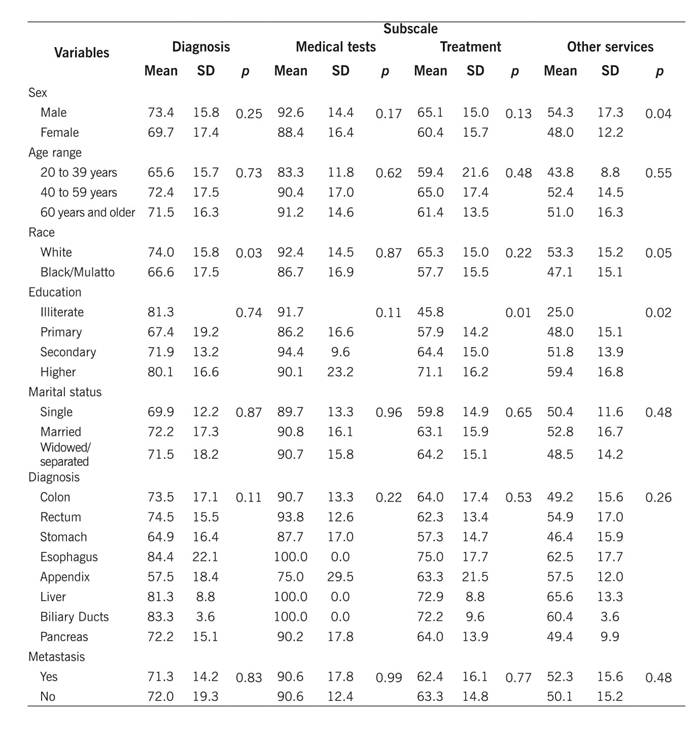
A similar analysis was developed for the isolated scale items (Table 5). For the sex variable, significant differences were found for the items addressing Information about other medical care locations (item 18) and self-care (item 19), with greater satisfaction among men. For race, a difference was found for overall satisfaction (item 22), with greater satisfaction among white patients. The remaining characteristics did not show any significant difference. It is important to mention that items 21 and 24 were excluded from the table because they presented 100% of “no” answers among the interviewees. In addition, no variability measure is shown for the “illiterate” category because there was only one subject.
Discussion
The amount of information mentioned as received about the disease, the medical tests and treatment was superior to the average score. We believe that this is related to the fact that the sample consists of patients hospitalized at a surgical ward, which means more medical tests and therapeutic conducts, consequently offering information about the test objectives and results and about the disease and treatment more constantly. This finding is similar to the observations by Adler et al.,12 in which the same questionnaire was applied to 72 patients and participants in the German study and to the phase IV study concerning the validation of the EORTC QLQ-INFO25 by Arraras et al.6 Almost all participants indicated some knowledge about the diagnosis of their oncologic disease. About 89% of the sample referred having received moderate or plenty of information. Studies in other countries have also evidenced that most patients received a lot of information about their diagnosis.6,12 It should be highlighted, however, that the amount of information referred does not translate the actual knowledge about the disease, as highlighted in the study by Ferraz Gonçalves et al.,13 which verified that most patients (72%) indicated knowing the diagnosis; nevertheless, not all patients affirmed the diagnosis in a way that clearly showed that they were aware of the nature of their disease. Although these study results show the predominance of plenty of information about the diagnosis, a difference exists between the information provided and the patients’ needs. The cultural and social differences, emotional issues and the range of communication patterns can characterize this difference.
What the information received about the possible causes of the disease is concerned, (41%) indicates having received no information and (39%) mentions having received little information, suggesting that the team did not even discuss the matter of exposure to the risk factors, an important approach in the prevention of gastrointestinal cancer and in the cases of relapse of the disease. Nunes14 confirms this result in the study developed in Lisbon in 2012, referring that 70% of the sample indicated not having any information about the possible causes of the disease. With regard to the small amount of information on the effects of the treatment on their sexual activity, a large proportion considered they had not received any information (80%), suggesting the relation with a lesser valuation of this theme in function of the disease and little room, for cultural reasons, to discuss the theme. These findings were also evidenced in another study,13 based on which we conjecture that the theme in difficult to manage in different cultures, as these studies cited were developed in different European countries.
Concerning the items about additional assistance beyond the hospital, such as help with activities of daily living, support groups, visits from nursing professionals, rehabilitation services, and other locations for medical care, outpatient clinic, at home, the results showed that most answers indicated no information about these items, reflecting the insufficient comprehensiveness of the actions and services in the local health system, resulting in the discontinuity of the rehabilitation care and treatments, which are extremely important for the cancer patients’ quality of life. These findings were supported by the results of the study by Matos,5 which described the validation process of the QLQ-INFO25 or Portuguese from Portugal, as well as by the results of Arras et al.6 and Pinto et al.,15 in the study developed at a Belgian cancer treatment center, involving patients under chemotherapy.
In that study, no association was found between the amount of information received and the sociodemographic and clinical characteristics studied. The validation study of the INFO25, developed by Arraras et al.,6 also evidenced the lack of statistical association between the sociodemographic characteristics and the items described above. Bozec et al.,16 then, in the multicenter study developed in 2016, involving 200 patients who received chemotherapy and/or radiotherapy for all cancer types, showed in the results that women were more dissatisfied with the items amount and utility of the information received when compared to men. Although some questions were answered satisfactorily, showing scores far superior to the average, it was observed that 89% of the sample indicates the desire to receive more overall information. This finding is very close to the results presented in other studies,12-16 based on which we can suppose that, to respond to the demand concerning the amount of information, the quality of the information provided should be taken into account, as many variables interfere in the absorption of the information, such as the patient’s way of life, the patient and family’s ability to understand the information and how they interpret the disease.
The general conclusion of this study is that the satisfaction with the information received was analyzed in patients diagnosed with abdominal cancer using the QLQ-INFO25 scale by EORTC. Despite the high level of satisfaction with the information received, it was observed that all patients would like further information, which shows us that repeating or offering new information continuously should be an ongoing process in care for these patients. The objective for health care should be to find ways of providing information that grant patients the support they need and want for the disease coping process, ranging from the diagnosis until end-of-life care. Thus, measuring the satisfaction with the information the cancer patient receives throughout the various phases of the disease and its treatment enables us to identify and rank the problems: monitor the treatment response and the health changes and promote better communication with the patient by training the care team involved, among other applications.











 texto em
texto em 

